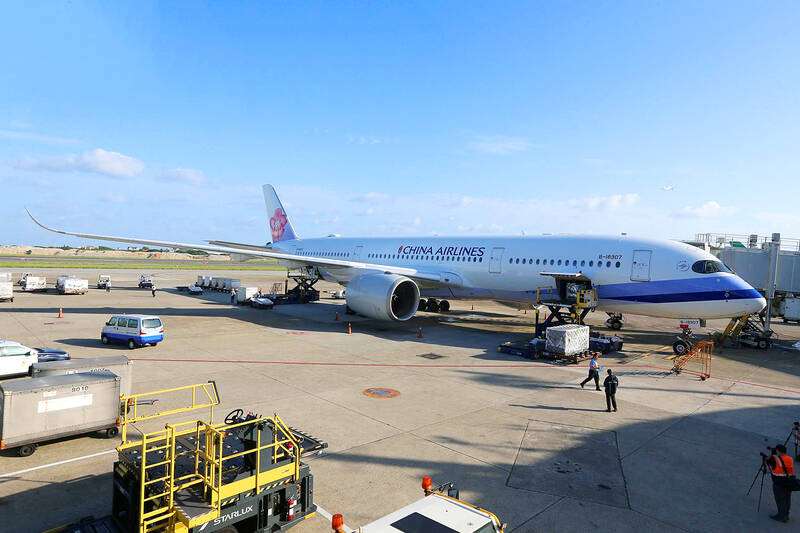China Airlines (CAL, 華航) is studying the feasibility of launching direct flights between Taiwan and Prague, Minister of Transportation and Communications Wang Kwo-tsai (王國材) yesterday told the legislature’s Transportation Committee.
Wang made the remarks in response to a question by Democratic Progressive Party (DPP) Legislator Hsu Chih-chieh (許智傑) about the ministry’s plan to stimulate the tourism sector as national borders are to reopen on Thursday next week.
While Taiwan offers direct flights to the UK and other destinations in western Europe, it has yet to offer direct flights to northern, central and east European countries, Hsu said.

Photo: CNA
“Taiwan and central and east European countries have grown closer in the past three years due to the COVID-19 pandemic, during which Taiwan donated masks to Europe and received vaccines donated by Lithuania, Slovakia, the Czech Republic and Poland,” Hsu added.
“Countries in eastern Europe were ruled by communists. Compared with their attitudes toward Russia and China, they have a better impression of Taiwan and think that Taiwanese are friendlier,” he said.
“Lawmakers from those countries have visited Taiwan as well, and vice versa. We should be able to launch more direct flight services to eastern Europe,” he said.
The government should consider offering direct flights to Sweden, the Czech Republic and Lithuania, he added.
Wang said flights to Prague could operate only if they have sufficient passengers.
Civil Aeronautics Administration Director-General Lin Kuo-hsien (林國顯) said that Taiwan and the Czech Republic have signed a civil aviation pact.
However, airlines must take into account various factors before launching new flights, Lin said, adding that CAL is the only carrier that has been asked to evaluate the feasibility of direct flights between Taiwan and Prague.
“There are more Taiwanese tourists who want to visit eastern Europe than eastern European tourists who want to visit Taiwan. As such, it would be difficult for the airline to sustain a flight service without picking up connecting passengers along the flight route,” Lin said.
Wang told Chinese Nationalist Party (KMT) Legislator Hung Meng-kai (洪孟楷) that the Mainland Affairs Council and the National Security Council are discussing whether the “small three links” connecting Penghu, Kinmen and Lienchiang counties with China’s Fujian Province would be resumed when the borders reopen.
Mainland Affairs Council Minister Chiu Tai-san (邱太三) told the legislature’s Internal Administration Committee that the Lunar New Year holiday next year might be a more appropriate time to resume the links.
“Even though the borders will soon be reopened, the Central Epidemic Command Center still limits the number of inbound travelers to 150,000 per week, which would in turn affect the number of inbound flights to Taiwan,” Chiu said when asked why he could only give a conservative estimate on the timeline.
The Chinese Communist Party’s attitude might also affect the timeline, Chiu said.
“They do not want to lose face and would prefer to keep things low profile. We have been working on some options, which might not work if we speak about them first. We will not reveal any details unless we make certain progress in this matter,” Chiu said.

The US government has signed defense cooperation agreements with Japan and the Philippines to boost the deterrence capabilities of countries in the first island chain, a report by the National Security Bureau (NSB) showed. The main countries on the first island chain include the two nations and Taiwan. The bureau is to present the report at a meeting of the legislature’s Foreign Affairs and National Defense Committee tomorrow. The US military has deployed Typhon missile systems to Japan’s Yamaguchi Prefecture and Zambales province in the Philippines during their joint military exercises. It has also installed NMESIS anti-ship systems in Japan’s Okinawa

‘WIN-WIN’: The Philippines, and central and eastern European countries are important potential drone cooperation partners, Minister of Foreign Affairs Lin Chia-lung said Minister of Foreign Affairs Lin Chia-lung (林佳龍) in an interview published yesterday confirmed that there are joint ventures between Taiwan and Poland in the drone industry. Lin made the remark in an exclusive interview with the Chinese-language Liberty Times (the Taipei Times’ sister paper). The government-backed Taiwan Excellence Drone International Business Opportunities Alliance and the Polish Chamber of Unmanned Systems on Wednesday last week signed a memorandum of understanding in Poland to develop a “non-China” supply chain for drones and work together on key technologies. Asked if Taiwan prioritized Poland among central and eastern European countries in drone collaboration, Lin

BACK TO WORK? Prosecutors said they are considering filing an appeal, while the Hsinchu City Government said it has applied for Ann Kao’s reinstatement as mayor The High Court yesterday found suspended Hsinchu mayor Ann Kao (高虹安) not guilty of embezzling assistant fees, reducing her sentence to six months in prison commutable to a fine from seven years and four months. The verdict acquitted Kao of the corruption charge, but found her guilty of causing a public official to commit document forgery. The High Prosecutors’ Office said it is reviewing the ruling and considering whether to file an appeal. The Taipei District Court in July last year sentenced Kao to seven years and four months in prison, along with a four-year deprivation of civil rights, for contravening the Anti-Corruption

NO CONFIDENCE MOTION? The premier said that being toppled by the legislature for defending the Constitution would be a democratic badge of honor for him Premier Cho Jung-tai (卓榮泰) yesterday announced that the Cabinet would not countersign the amendments to the local revenue-sharing law passed by the Legislative Yuan last month. Cho said the decision not to countersign the amendments to the Act Governing the Allocation of Government Revenues and Expenditures (財政收支劃分法) was made in accordance with the Constitution. “The decision aims to safeguard our Constitution,” he said. The Constitution stipulates the president shall, in accordance with law, promulgate laws and issue mandates with the countersignature of the head of the Executive Yuan, or with the countersignatures of both the head of the Executive Yuan and ministers or